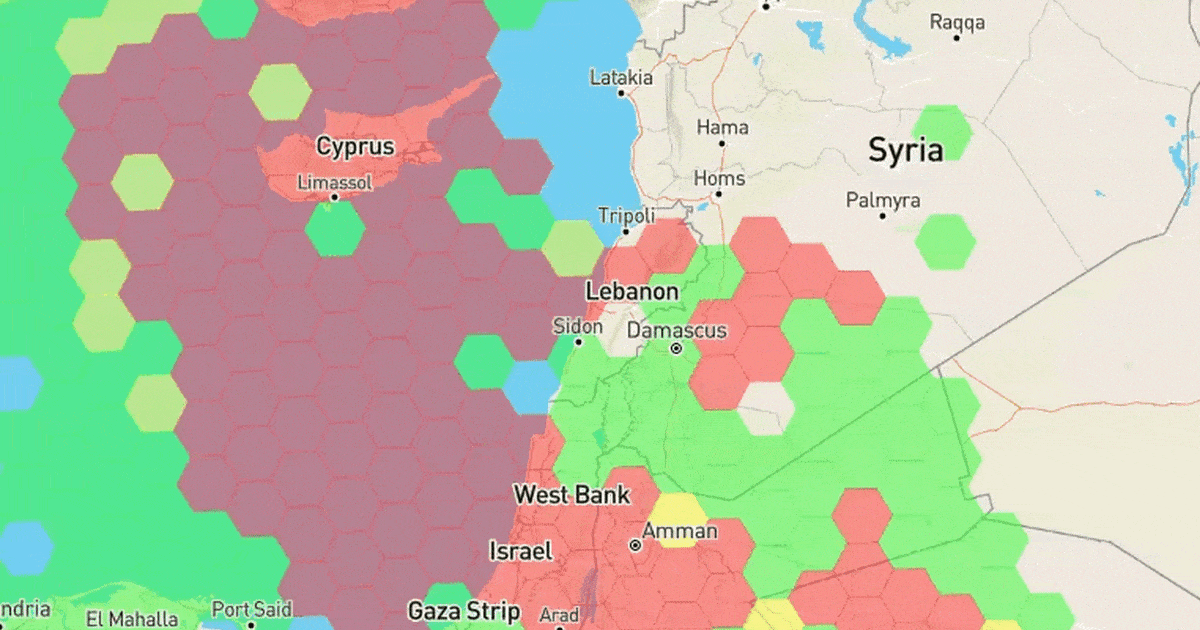electronic jamming in October 7 2023 attack on israel – GS https://t.co/hE7CUEHPvg pic.twitter.com/iuiExpmXOe
— Michael Novakhov (@mikenov) December 27, 2023
Day: December 27, 2023

In Iran, Iraq, Jordan, Lebanon, Syria, Turkey, and elsewhere in the Middle East, protests have erupted following the October 7 attack in solidarity with the Palestinians, in opposition of Israel and its supporters, and, in some cases, in explicit support for Hamas. In major cities throughout Africa, protestors have expressed solidarity with Palestinians and denounced Israel’s actions. Asian states such as Bangladesh, India, Indonesia, Japan, Malaysia, and the Philippines have seen pro-Palestinian protests. In Europe, North America, and South America, countries such as France, Germany, Norway, Romania, Spain, the United Kingdom, Canada, the United States, Brazil, Argentina, and Uruguay have experienced both pro-Israel and pro-Palestinian protests. Some countries, such as France, Germany, and India, have tried to implement prohibitions on protests in support of Palestinians, citing concerns related to public order and anti-Semitic incidents, though several large pro-Palestinian demonstrations have still taken place in all three countries.
Figure 10: Protest in London in Response Violence in Gaza

However, the Israeli jamming can also mess up the IDF’s rocket warning app ■ U.S. researchers recently geolocated a powerful GPS jammer at base in northern Israel
Oct 16, 2023
Israeli defense forces have increased GPS jamming in the region to try to thwart drone attacks by Hamas and Hezbollah.
HPJ20-H – All frequencies desktop jammer (20 bands) https://t.co/9nocUdcyIL
— Michael Novakhov (@mikenov) December 27, 2023
APJ-16 – portable All in one jammer – Google Search https://t.co/VDuDgdikcE pic.twitter.com/bIeOGs095H
— Michael Novakhov (@mikenov) December 27, 2023

A screenshot from open-source satellite navigation interference tracking website, GPSjam.org from … [+] October 29 shows extensive navigational signal jamming in and around Israel but the area around Gaza near the Egypt border shows no activity.
GPSJam.org
While a number of reports describe Israeli jamming of GPS signals to thwart Hamas drones, there have been suggestions that Hamas itself is jamming satnav signals.
According to a recent article in the Israeli press, the country has stepped up efforts to jam or spoof GPS/GNSS signals to disrupt potential drone and missile attacks in northern Israel from Lebanon-based Hezbollah. It has also interfered with satellite navigation in and around Gaza.
The Israel Defense Force (IDF) said in a statement to Haaretz that it is disrupting satellite navigation systems “in a proactive manner for various operational needs… Citizens should be aware that the disruption can cause various and temporary effects on location-based applications.”
Observations by Israelis in northern Israel along the frontier with Lebanon appear to confirm the jamming with users noting occasional loss of GPS signals. GPS-enabled interactive navigation apps (Waze, Google, Apple) are apparently not showing traffic data or reports even when the GPS is working.
Real-time traffic data may have been purposely disabled to prevent Hezbollah or others from spotting patterns which may indicate the location of roadblocks or the movements of IDF formations in the area.
However, these observations relate to northern Israel as do most reports on jamming in the region. The latest public snapshot of jamming-spoofing activity from open-source GNSS (global navigation satellite system) interference tracking website GPSJAM shows significant jamming activity around Israel and the eastern Mediterranean region.
But it does not indicate jamming-spoofing activity in the lower lefthand corner of the Israel map overlay above where Gaza sits near the Egyptian border. That may be because there is not active jamming by Hamas or that such jamming is so localized that the tracking sensors that sites like GPSJAM aggregate data from cannot pick it up.
There is a thriving global market for consumer GPS-jamming devices. A quick browse online yields numerous choices for users seeking to evade GPS tracking with low-power devices that disrupt commercial GPS signals. One example is the APJ-16, a $1,200 all-in-one portable jammer.
The APJ-16 is advertised as an all-in-one portable GPS jammer capable of blocking signals on 16 … [+] frequencies at a range of 30 meters.
Jammer-store.com
According to the ad for the device, the APJ-16 can block GPS signals at 16 different frequencies in the 164-5900 MHz band. Users can “can select the frequencies you want to mute to leave others free,” a feature which might be useful for Hamas. The small four-pound (1.8 kg) device has a range of 30 meters (100 ft.) and a battery life of three hours.
Such power and range would theoretically be useful in throwing off the aerial or terrestrial drones which Israeli forces are now operating in Gaza. A 2020 feature in online blog Hackaday on commercially available mini GPS jammers illustrated their function and effectiveness.
Noting that the bulk of the GPS constellation is located at a significant distance (an altitude of 12,500 miles) from the earth’s surface and that antennas on most GPS-equipped devices – phones and to a lesser extent, drones – are quite small, the author pointed out that the signals they receive are weak.
“It doesn’t take much to overpower the legitimate signal,” Hackaday observed. “Keep in mind that a device like this isn’t trying to mimic a GPS satellite, it’s simply broadcasting out enough loud nonsense that the real satellite can no longer be heard.”
While the military grade drones the IDF is using have larger antennas and may enjoy greater signal strength, jammers like the APJ-16 go beyond simple mini car-tracker jammers.
One Israeli drone-maker currently claims that its platforms and operating system are the only drones not affected by Hamas’s GPS blocking efforts. I queried the company regarding this claim but received no response by publication time.
Information on how to build GPS jammers with commercial electronic components has been available for years and Hamas, Hezbollah and many other non-state actors have surely studied it. So have states like Iran which could possibly have provided Hamas and other terror groups with its own jamming equipment or jammers acquired on the open market.
Low power GPS jammers might not be visible to open-source tracking yet because they have not been activated as the IDF has only just begun to penetrate Gaza. Israel and the U.S. likely have intelligence (human or signals intel) as to whether they are present in numbers in Gaza or not.
But there is the possibility that they could be tactically relevant and play a role in the street battles now unfolding. As Hackaday’s author noted, the efficacy of devices costing as little as $8 is concerningly potent.
“Part of me assumed that the Mini GPS Jammer just wouldn’t work, or at least, it would work so poorly as to not be an issue. But no, in a break from tradition, a cheap imported device from eBay managed to actually exceed all of my expectations.”
If more powerful, sophisticated commercial or state-supplied portable GPS blockers can do better, another one of the technological advantages that Israel may have expected could be eroded.
electronic jamming in October 7 2023 attack on israel – Google Search https://t.co/CPh3M6LDey pic.twitter.com/qzDhkiy7RX
— Michael Novakhov (@mikenov) December 27, 2023

Armenia and Azerbaijan are moving towards bringing the peace treaty to the finish line, said Dmitry Peskov, press secretary of the Russian president, RIA Novosti reported.
“We [i.e. Russia] really document that the [two] countries are moving in the direction of bringing the peace treaty to the finish line. We hope that it will happen as soon as possible; of course, not to the detriment of quality. Therefore, together with everyone, we are waiting for when that work will be completed. The main thing is that we see the presence of [respective] political will on both sides, both in Baku and Yerevan. And of course, we support it,” Peskov told reporters.
He noted that the signing of the aforesaid peace treaty will be useful for the peace and stability in both countries and the entire region.
The leaders of Armenia and Azerbaijan did not negotiate in Saint Petersburg, Russia on Tuesday, but all of them had the opportunity to have short contacts, Peskov noted.
“No, they did not hold negotiations yesterday. But such events, including the informal CIS summit, are always a good opportunity for short contacts on foot; it happened like that this time as well. Everyone had the opportunity to communicate on foot with each other on some key moments,” said the Kremlin spokesperson.
Prime Minister Nikol Pashinyan and President Ilham Aliyev of Azerbaijan on Tuesday discussed the peace process between their countries during a meeting in St. Petersburg, Russia on the margins of a Commonwealth of Independent States summit.
Pashinyan’s press secretary Nazeli Baghdasaryan told Azatutyun.am about the “informal meeting,” saying the talks were “bilateral, meaning the two leaders talked without a third country mediator — in this case Russia — president.
“Issues related to the Armenia-Azerbaijan peace agenda were discussed. The discussions were in a bilateral format,” Baghdasaryan said, without elaborating.
It was the first time the two leaders were meeting since Azerbaijan’s large-scale attack on Artsakh in September, which forced the displacement of more than 100,000 Artsakh residents. Aliyev and his foreign minister, Jeyhum Bayramov, canceled scheduled meetings in Brussels and Washington, respectively, scheduled after the September attack.
Earlier on Tuesday, Russian media outlets circulated a short video showing Pashinyan and Aliyev shaking hands during an excursion to the Tsarskoe Selo State Museum and Heritage Site in Saint Petersburg as CIS leaders entered the venue ahead of the unofficial CIS summit.
President Vladimir Putin of Russia had invited the leaders of CIS countries — Armenia, Azerbaijan, Belarus, Kazakhstan, Kyrgyzstan, Tajikistan, Turkmenistan and Uzbekistan — to discuss issues not in a meeting format, but during an excursion in the palace-park complexes of Saint Petersburg.
Pashinyan also met with President Alexander Lukashenko of Belarus, who last month hosted a meeting of the Collective Security Treaty Organization in Minsk. The Armenian prime minister did not attend that gathering.
The Kremlin’s spokesperson Dmitry Peskov told Russia’s Channel One television that the leaders of Armenia and Azerbaijan have expressed interest in signing a peace deal.
“They are ready to conclude peace negotiations, issue a joint document, to sign the peace treaty,” Peskov said.
1/7 The Prime Minister of Armenia and the President of Azerbaijan addressed peace-related issues in St. Petersburg, Russia, as conveyed by Prime Minister’s spokesperson Nazeli Baghdasaryan to RFE/RL. “During the informal summit of the CIS, informal contacts took place pic.twitter.com/jdhYe2dWbH
— Adnan Huseyn (@adnanhuseyn) December 27, 2023
